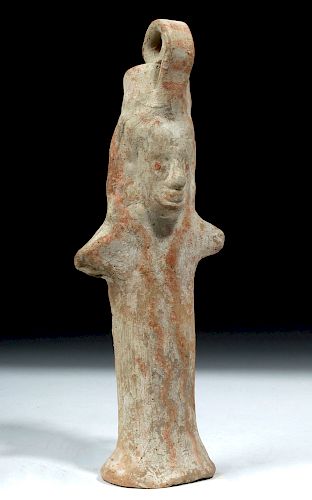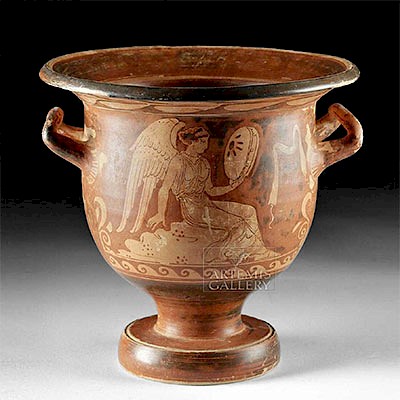Archaic Greek Boeotian Pottery Idol
Lot 22
About Seller
Artemis Fine Arts
686 S Taylor Ave, Ste 106
Louisville, CO 80027
United States
Selling antiquities, ancient and ethnographic art online since 1993, Artemis Gallery specializes in Classical Antiquities (Egyptian, Greek, Roman, Near Eastern), Asian, Pre-Columbian, African / Tribal / Oceanographic art. Our extensive inventory includes pottery, stone, metal, wood, glass and textil...Read more
Estimate:
$1,700 - $2,550
Absentee vs Live bid
Two ways to bid:
- Leave a max absentee bid and the platform will bid on your behalf up to your maximum bid during the live auction.
- Bid live during the auction and your bids will be submitted real-time to the auctioneer.
Bid Increments
| Price | Bid Increment |
|---|---|
| $0 | $25 |
| $300 | $50 |
| $1,000 | $100 |
| $2,000 | $250 |
| $5,000 | $500 |
| $10,000 | $1,000 |
| $20,000 | $2,500 |
| $50,000 | $5,000 |
| $100,000 | $10,000 |
| $200,000 | $20,000 |
About Auction
By Artemis Fine Arts
Mar 7, 2019
Set Reminder
2019-03-07 10:00:00
2019-03-07 10:00:00
America/New_York
Bidsquare
Bidsquare : VARIETY SALE | Antiquities & Ethnographic Art
https://www.bidsquare.com/auctions/artemis-gallery/variety-sale-antiquities-ethnographic-art-3928
Around the world & back in time - be amazed at the treasures you will find. Antiquities from Egypt, Greece, Italy and the Near East, Asian, Pre-Columbian, African / Tribal / Oceanic, Native American, Spanish Colonial, Russian Icons, Fine Art, much more! Artemis Fine Arts info@artemisgallery.com
Around the world & back in time - be amazed at the treasures you will find. Antiquities from Egypt, Greece, Italy and the Near East, Asian, Pre-Columbian, African / Tribal / Oceanic, Native American, Spanish Colonial, Russian Icons, Fine Art, much more! Artemis Fine Arts info@artemisgallery.com
- Lot Description
Greece, Tanagra, Boeotia, Archaic Period, ca. 6th century BCE. A terracotta figure of what is probably a female worshipper. She has a simplified body composed of a cylinder that flares outward at her feet, allowing her to stand on her own. Projecting from the upper body are two outstretched, tapering, arm-like forms. The head has a large face with clear, naturalistic details that are in strong contrast to the simple form of the body. Atop the head is a polos crown with an attached frontispiece that curls up over the top of the head. Red paint on the buff fired clay surface forms wavy lines that travel vertically down the body and horizontally around the frontispiece. The polos crown may signify a goddess, but in this case it probably signifies a woman of high social standing - idols are often representative of worshippers rather than gods, and at this time in history wealthy women are shown wearing the polos. The outstretched arms are another common feature of ancient idols, thought to signify an act of supplication, as are the large eyes, thought to indicate watchfulness to the gods. Size: 2.6" W x 6.6" H (6.6 cm x 16.8 cm)
This idol represents an early form of Greek sculpture, inspired by Corinth, where the body has been fashioned free hand, while the face is shaped with a mold. These were the precursors to the increasingly lifelike, naturalistic sculptures that Tanagra would be known for later in Greek history. They demonstrate a fundamental change in thinking about the human form in art.
Provenance: private Swiss collection
All items legal to buy/sell under U.S. Statute covering cultural patrimony Code 2600, CHAPTER 14, and are guaranteed to be as described or your money back.
A Certificate of Authenticity will accompany all winning bids.
We ship worldwide and handle all shipping in-house for your convenience.
#124159Repaired from two pieces, with well-done and difficult to see repairs.Condition
- Shipping Info
-
All shipping is handled in-house for your convenience. Your invoice from Artemis Gallery will include shipping calculation instructions. If in doubt, please inquire BEFORE bidding for estimated shipping costs for individual items.
-
- Buyer's Premium



 EUR
EUR CAD
CAD AUD
AUD GBP
GBP MXN
MXN HKD
HKD CNY
CNY MYR
MYR SEK
SEK SGD
SGD CHF
CHF THB
THB

















